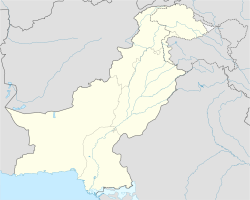Top Qs
Timeline
Chat
Perspective
Parachinar
City in Khyber Pakhtunkhwa, Pakistan From Wikipedia, the free encyclopedia
Remove ads
Parachinar (Pashto: پاړه چنار; Urdu: پاڑہ چنار) is a city and the capital of the Kurram District in the province of Khyber Pakhtunkhwa, Pakistan.[2]
This article possibly contains original research. (September 2017) |
Parachinar, situated on the west of Peshawar, juts into the Paktia, Logar and Nangarhar provinces of Afghanistan. With a distance of 110 kilometres (68 mi) from the capital of Afghanistan Kabul, Parachinar is the closest city in Pakistan to Kabul.
Remove ads
History
Summarize
Perspective
The British soldier and historian C. M. Enriquez described the early history of Parachinar in his book The Pathan Borderland. He writes that Malak (leader) Pare was a reputable Malak of the Pare Khel tribe, a sub-tribe Turi (Shia) tribe, planted Poplar trees some 200 years ago. Before much settlement, the area was mostly arid. In terms of distribution, the ancient Poplar tree and the surrounding land belonged to the Parakhel tribe. This ownership is still authentic in official records or deeds of property. Parakhel tribesmen used to cultivate wheat in this desert area. During the wheat harvest, tents were pitched here, and in the shade of this poplar tree, jirgas and consultations were held.[3]
Durand Line Agreement
In 1893, during the rule of Abdur Rahman Khan (Barakzai dynasty) of Afghanistan, a Royal Commission for demarcating a boundary between Afghanistan and the territory of British governed India negotiated terms, agreeing to the Durand line.[4]
From the British side, the camp was attended by Sir Mortimer Durand and Sahibzada Abdul Qayyum, assistant political agent, Khyber Agency.[5] The Afghanistan interest was represented by Sahibzada Abdul Latif and the Governor of Khost Sardar Shireendil Khan, represented King Amir Abdur Rahman Khan.[6]
2007 Kurram Agency conflict
Intermittently, conflicts arise stemming from personal issues(mostly religious ones) within this region. In instances where one sect initiates an attack on another, it often leads to retaliatory actions by the aggrieved party.[7]
Violent clashes in the region occurred in the following week until a ceasefire was reached on 12 April 2007.[8]
Terrorist incidents
Parachinar has been the target of several terrorist attacks from 2007 to 2014 in which over 3000 people have died, making it the second-most targeted Pakistani city by militants after Peshawar.[9]
Remove ads
Climate
Summarize
Perspective
Parachinar has a moderate humid subtropical climate (Köppen climate classification Cfa). Although the city's southeasterly aspect relative to the valley in which it is situated allows it to receive on occasions significant monsoonal rainfall, the most frequent source of rain is western depressions and related thunderstorms. During the winter, snowfall is common, and frosts occur on most mornings. Snow closes the Peiwar Pass, located on the Paktia border just over 20 km west of Parachinar, for up to five months per year.
Remove ads
Demographics
Population
As of the 2023 census, Parachinar had a population of 5,583.[16][17]
Education
FATA University plans to open a sub-campus at Parachinar.[18]Parachinar also host KMU Institute of Health Sciences as an affiliated institute of Khyber Medical University. The institute is offering BS-Nursing and BS-Surgical under the umbrella of KMU. [19]
Transportation
The Thall-Parachinar road is the main road connecting Parachinar to the rest of the country.[20]
Parachinar has an airport but currently it is non-functional. In the past there was a flight service between Peshawar and Parachinar.[21][22]
See also
References
Wikiwand - on
Seamless Wikipedia browsing. On steroids.
Remove ads



